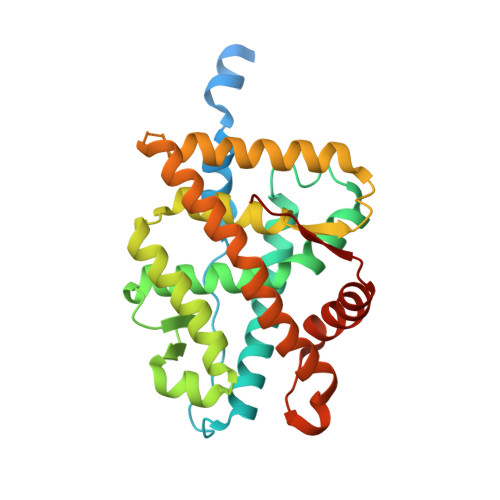Identification of Benzoxazin-3-one Derivatives as Novel, Potent, and Selective Nonsteroidal Mineralocorticoid Receptor Antagonists
Hasui, T., Matsunaga, N., Ora, T., Ohyabu, N., Nishigaki, N., Imura, Y., Igata, Y., Matsui, H., Motoyaji, T., Tanaka, T., Habuka, N., Sogabe, S., Ono, M., Siedem, C.S., Tang, T.P., Gauthier, C., De Meese, L.A., Boyd, S.A., Fukumoto, S.(2011) J Med Chem 54: 8616-8631
- PubMed: 22074142
- DOI: https://doi.org/10.1021/jm2011645
- Primary Citation of Related Structures:
3VHU, 3VHV - PubMed Abstract:
Mineralocorticoid receptor (MR) blockade has come into focus as a promising approach for the treatment of cardiovascular diseases such as hypertension and congestive heart failure. In order to identify a novel class of nonsteroidal MR antagonists that exhibit significant potency and good selectivity over other steroidal hormone receptors, we designed a novel series of benzoxazin-3-one derivatives and synthesized them from 6-(7H-[1,2,4]triazolo[3,4-b][1,3,4]thiadiazin-6-yl)-2H-1,4-benzoxazin-3(4H)-one (1a), high-throughput screening (HTS) hit compound. Our design was based on a crystal structure of an MR/compound complex and a docking model. In the course of lead generation from 1a, a 1,2-diaryl framework was characterized as a key structure with high binding affinity. On the basis of scaffold hopping and optimization studies, benzoxazin-3-one derivatives possessing 1-phenyl-3-trifluoromethylpyrazol-5-yl moiety at the 6-position were identified as a novel series of potent and selective MR antagonists. Among these compounds, 6-[1-(4-fluoro-2-methylphenyl)-3-(trifluoromethyl)-1H-pyrazol-5-yl]-2H-1,4-benzoxazin-3(4H)-one (14n) showed highly potent activity and good selectivity and also exhibited a significant antihypertensive effect in deoxycorticosterone acetate-salt hypertensive rats. On the basis of these results, compound 14n was progressed for further pharmacological evaluation.
Organizational Affiliation:
Pharmaceutical Research Division, Takeda Pharmaceutical Company Ltd., 26-1, Muraoka-higashi 2-chome, Fujisawa, Kanagawa 251-8555, Japan. [email protected]















